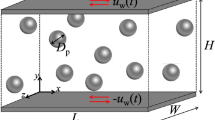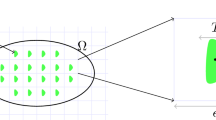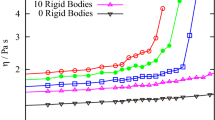Abstract
We report on the modelling of a magneto-rheological (MR) suspension bound between shearing parallel plates using a particle-level numerical simulation. The simulation is similar to an approach used previously but includes particle hydrodynamic interaction using elements of the Stokesian-dynamic method. Observations of initially chain-like aggregations are reported, and the evolving morphology of suspension particle clusters is explored. Our early-strain observations concur with the prevailing ideas of experimentalists on the important role that the microstructure has on bulk viscosity. We then study in particular the effects of simulation size and strain on viscosity. While initial viscous response is similar to previously reported observations in the literature, when left to run for longer strains, suspensions evolved into markedly different microstructures from those observed experimentally, or in electro-rheological suspensions, or MR simulations with artificial wall interaction. Substantial qualitative and quantitative divergence was observed over long strains. We argue that this divergence is due to the lack of a particle–wall interaction model for MR fluids. While current theories in MR modelling do not justify the requirement for a particle–wall interaction, these results suggest that one is required in order to match experimental observations.











Similar content being viewed by others
Notes
Without interparticle hydrodynamic interaction.
References
Binous H, Phillips RJ (1999) The effect of sphere-wall interactions on particle motion in a viscoelastic suspension of FENE dumbbells. J Non-Newton Fluid Mech 85:63–92
Bonnecaze RT, Brady JF (1992) Dynamic simulation of an electrorheological fluid. J Chem Phys 96(3):2183–2202
Brady JF, Bossis G (1988) Stokesian dynamics. Annu Rev Fluid Mech 20:111–157
Cox BJ, Thamwattana N, Hill JM (2006) Electric field-induced force between two identical uncharged spheres. Appl Phys Lett 88:152903, April
Craig B (2003) One fluid, multiple viscosities—numerous applications. AMPTIAC Q 7(2):15–19
Finlayson BA (1980) Nonlinear analysis in chemical engineering. McGraw-Hill International, New York
Kirkwood JG, Riseman J (1948) The instrinsic viscosities and diffusion constants of flexible macromolecules in solution. J Chem Phys 16(6):565–573, June
Kittipoomwong D, Klingenberg DJ, Ulicny JC (2005) Dynamic yield stress enhancement in bidisperse magnetorheological fluids. J Rheol 49(6):1521–1538, November
Klingenberg DJ, Swol FV, Zukoski CF (1989) Dynamic simulation of electrorheological suspensions. J Chem Phys 91(12):7888–7895, December
Klingenberg DJ, Swol FV, Zukoski CF (1991a) The small shear rate response of electrorheological suspensions. I. Simulation in the point-dipole limit. J Chem Phys 94(9):6160–6169, May
Klingenberg DJ, Swol FV, Zukoski CF (1991b) The small shear rate response of electrorheological suspensions. II. Extension beyond the point-dipole limit. J Chem Phys 94(9):6170–6178, May
Marshall L, Zukoski CF, Goodwin JW (1989) Effects of electric fields on the rheology of non-aqueous concentrated suspensions. J Chem Soc Faraday Trans 85(9):2785–2795
Martin JE (2000) Thermal chain model of electrorheology and magnetorheology. Phys Rev E 63:0114061–0114069
Parthasarathy M, Klingenberg DJ (1996) Electrorheology: mechanisms and models. Mater Sci Eng R17(2):57–103
Rotne J, Prager S (1969) Variational treatment of hydrodynamic interaction in polymers. J Chem Phys 50(11):4831–4837
See H, Doi M (1991) Aggregation kinetics in electro-rheological fluids. J Phys Soc Jpn 60(8):2778–2782, August
See H, Doi M (1992) Shear resistance of electrorheological fluids under time-varying electric fields. J Rheol 36(6):1143–1163, August
Sim HG, Ahn KH, Lee SJ (2003) Three-dimensional dynamics simulation of electrorheological fluids under large amplitude oscillatory shear flow. J Rheol 47(4):879–895, July
Tao R (ed) (1999) Field-induced rheology in uniaxial and biaxial fields. World Scientific Publishing, Singapore, July 1999
Toor WR (1993) Structure formation in electrorheological fluids. J Colloid Interface Sci 156:335–349
Whittle M (1990) Computer simulation of an electrorheological fluid. J Non-Newton Fluid Mech 37:233–263
Yamakawa H (1970) Transport properties of polymer chains in dilute solution: hydrodynamic interaction. J Chem Phys 53(1):436–443
Acknowledgements
We gratefully acknowledge the support of the Australian Research Council.
Author information
Authors and Affiliations
Corresponding author
Rights and permissions
About this article
Cite this article
Joung, C.G., See, H. The influence of wall interaction on dynamic particle modelling of magneto-rheological suspensions between shearing plates. Rheol Acta 47, 917–927 (2008). https://doi.org/10.1007/s00397-008-0282-3
Received:
Revised:
Accepted:
Published:
Issue Date:
DOI: https://doi.org/10.1007/s00397-008-0282-3




